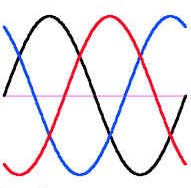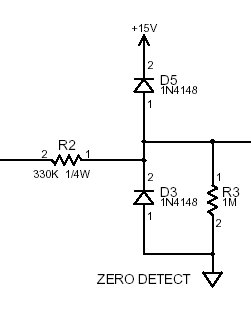
| Figure 1: One cycle of
split phase AC power. One phase is shown in red and the other in
black. Note that the phases are 180 degrees apart. |
|
| Figure 2: Split phase AC
power. Note that both phases cross zero together, as marked by
the vertical red bars. The phases cross each other at zero.
In other words, when there is no potential difference between the
phases, there is also zero potential to ground as well. at 90 and
270 degrees, the difference between phases is at its maximum potential
(long green line) The short green marks indicate the timing of
X10 pulse transmission. The two pulses after the zero crossing
are designed to coincide with the zero crossing of the second and third
phase. |
|
| Figure 3: 3 phase AC
power. Note the three phases are 120 degrees apart, and each
phase crosses zero independently. Because of this, three phase
power is more efficient since there is always voltage present.
With single phase power, current stops flowing briefly 120 times per
second during the zero crossing. |
 |
| Figure 4: Three phase
power as applied to the appliance module. For 208V three phase,
only two phases are used. The peak potential between the phases
(green line) is less than for single phase circuit since one phase (red
in this illustration has passed its peak while the other is approaching
it. Note that the zero crossings relative to baseline (pink line)
do not correspond to where the phases cross each other (thin vertical
red lines). The appiance module does not have a ground reference
(the pink line in this case), so the zero crossing detector detects
zero crossing when the phases cross. |
|
| Figure 5: Three phase
power showing timing of X10 signals. Note that the X10 signals
are sent and correspond to the zero crossing of each of the three
phases. Note that at the crossing of any two phases (red bars,
and what is detected as zero by the 220V appliance module, no X10
signal is present). The designers thought about 3 phase
power, but didn't consider 208 V three phase, or they would have
transmitted 6 pulses per cycle, one every 30 degrees (1.389 ms).
With 50 Hz power, the problem is worse, since if a 60 Hz transmitter is
used, the second and third phase will be mistimed. It probably
would have been better if they just made the pulse last for the entire
half cycle. But they didn't. |

| Figure 6: The outer housing has been disassembled by removing the four screws in the corner. The module acutally contains a wall outlet module. I would assume this modification could also be used on the receptacle version of this unit. | |
| Figure 7: The receptacle
module itself is opened by removing the two screws on the back and
carefully sliding the cover down the power leads (red arrows). It
is not necessary to remove the circuit board for this
modification. Note the smaller black (upper left) white (lower
left) and blue (diagonal upper right to lower left) wires. These
provide power (each of the two input phases) through the black and
white, and power on detection through the blue. Functionally, the
white wire is the same as the neutral in 120 VAC applications.
(It is NOT neutral here) |
|
| Figure 8: Identify the
330K (orange-orange-yellow) 1/2 watt resistor. This resistor
couples the zero crossing signal from the Line 2 ("neutral" in the
device schematics, actually the opposite phase of the input) to the IC. |
|
| Figure 9: Cut the lead of
the 330K resistor as shown and remove the sleeving. Cut the lead
as close the the circuit board as possible. |
|
| Figure 10: Solder a length
of wire to the cut end of the resistor lead. Place heat
shrink tube over the resistor and connection as shown. To bring
the lead out of the housing, you can either drill a hole in the back,
or bring it out through one of the unused corner holes. If you
use the corner holes, you'll have to make a notch at the inside to
allow the case to close all the way (area shown with arrows in Figure
2, but on the opposite side). Once outside, the wire may be connected to the ground prong. You can disconnect the connector and solder it on. If you are mounting the module in a junction box as a receptacle, the wire should be connected to "neutral." (the grounded conductor), and white wire should be used. That's it. Carefully reassemble the module being careful not to pinch any wires. An ohmmeter check is recommended. Measure the resistance between each blade of the plug and the round prong. If either is less than 330,000 ohms, recheck your wiring before using. Plug the module into the 220V outlet without an appliance plugged in. Send "ON" and "OFF" commands and listen for the click of the module. If you don't hear it, go back and check your work. It could also indicate a defective ground. Not pictured: there is room in the housing to put a 0.1 MFD 600 V capacitor and 18 mH choke in series across the line to allow the module to also serve as a phase coupler. |